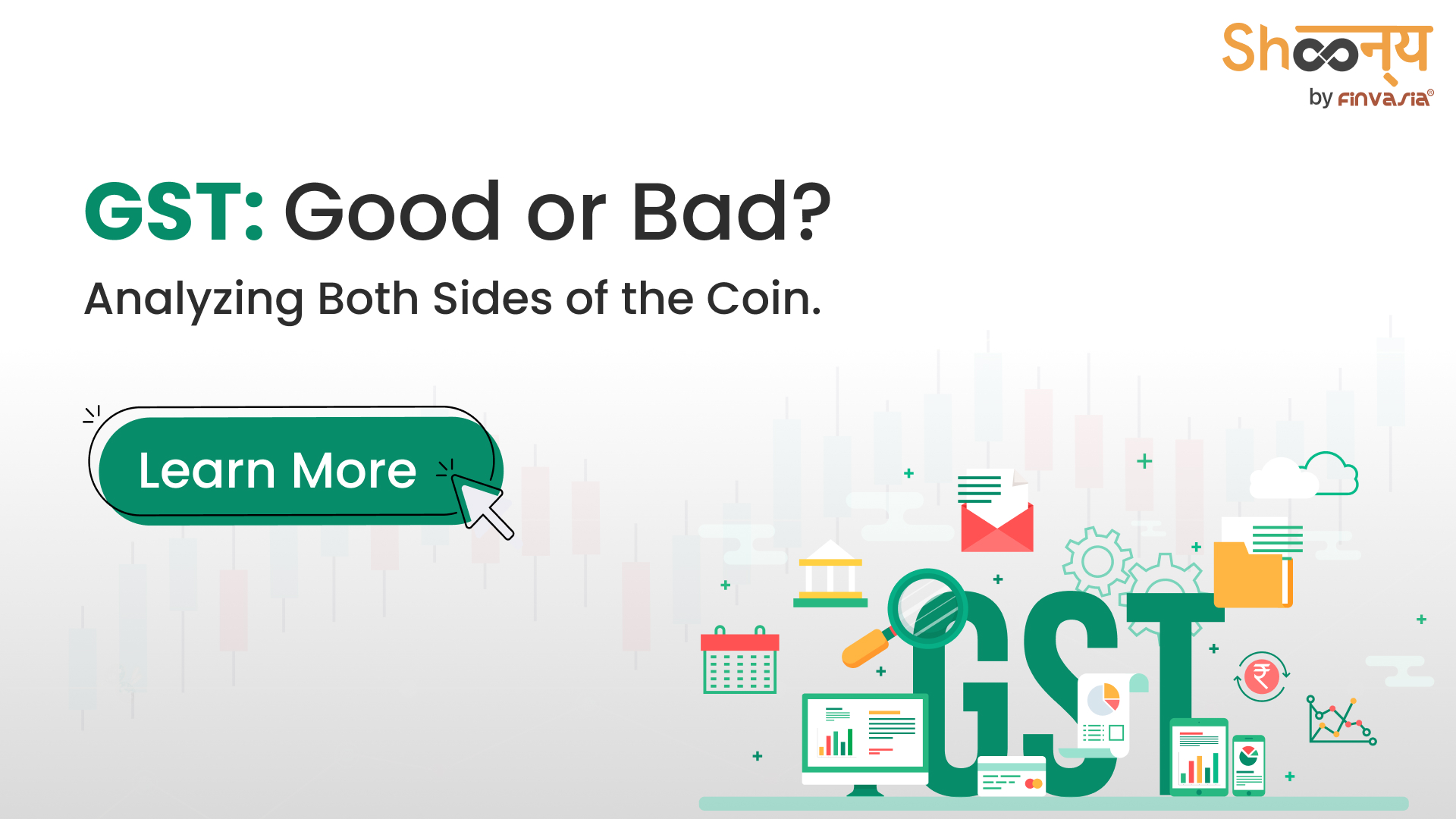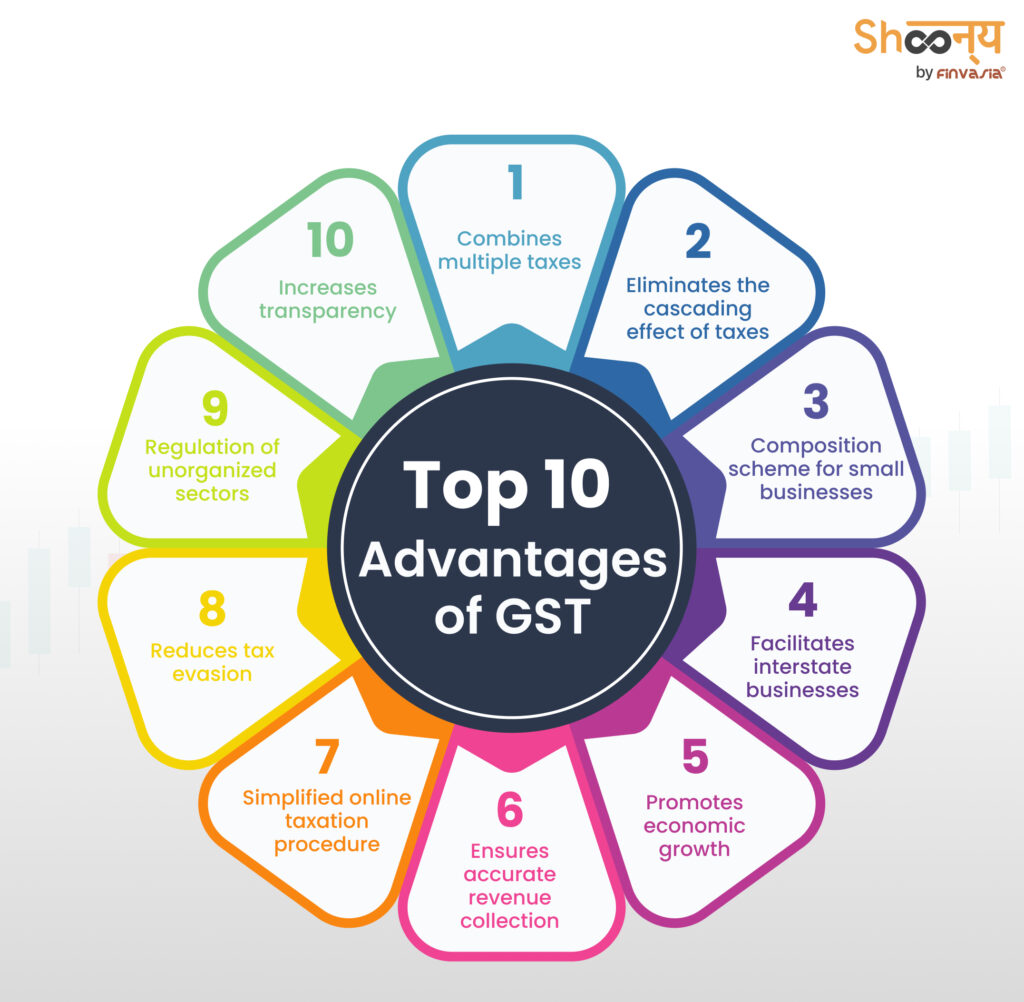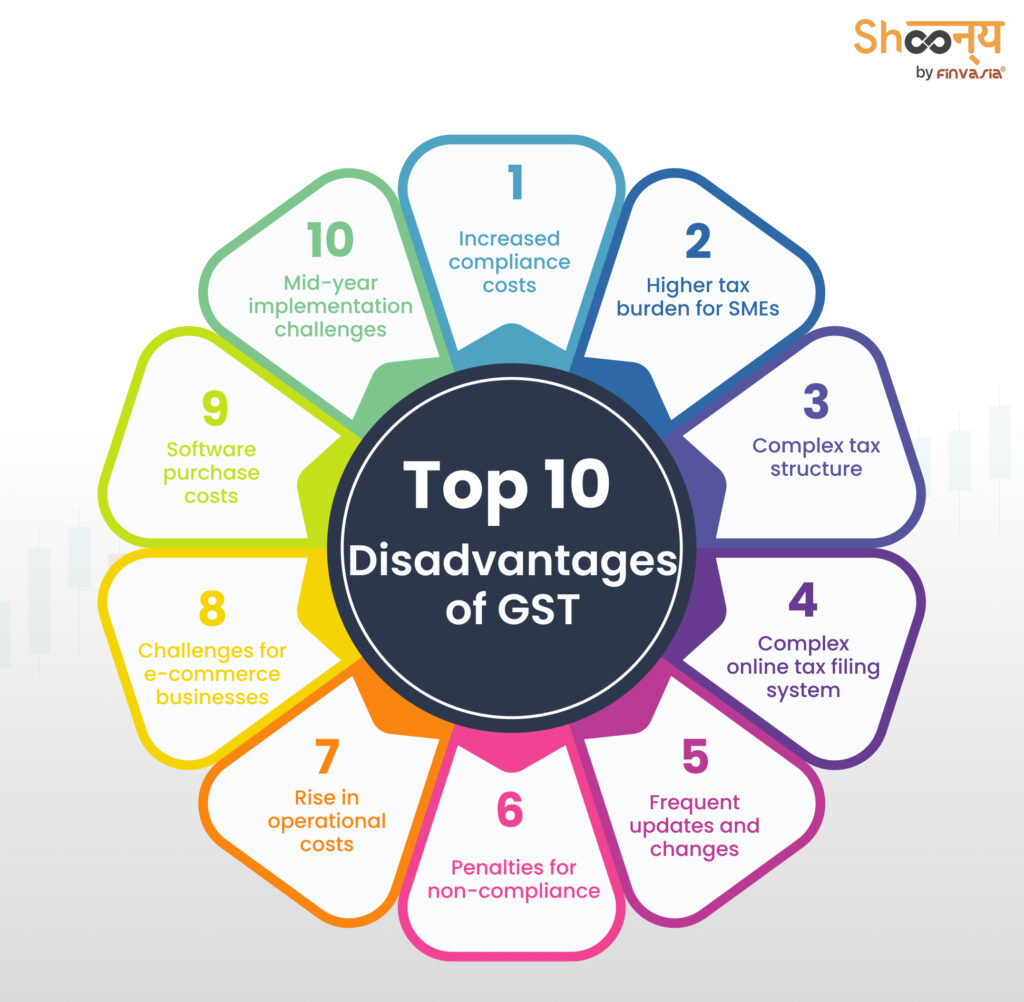10 Must-Know Advantages and Disadvantages of GST: Know the Real Impact

The Goods and Services Tax (GST) is a major reform introduced to simplify the tax system in India. Before GST, businesses faced multiple indirect taxes like excise duty, VAT, and service tax, collected by both the Central and State governments. GST was introduced to streamline these processes and create a more integrated market. However, this shift brought about both advantages and disadvantages of GST. Some people found the new tax rules and procedures complex and burdensome.
So, what are the real impacts?
Here’s a detailed look at the key advantages and disadvantages of GST to help you understand its effects better.
Brief History of GST
The Goods and Services Tax (GST) was launched in India on July 1, 2017. It is a comprehensive tax applied at multiple stages and is destination-based. This means that it is levied on every value addition.
Why did GST replace VAT?
The goal was to substitute the existing complicated and fragmented tax system with a unified one. This could simplify compliance, reduce tax cascading, and promote economic integration.
Under the Indian GST, goods and services are categorised into different tax slabs: 5%, 12%, 18%, and 28%. Some essential commodities are exempt from GST, while gold and job work for diamonds attract a lower tax rate.
Now, let’s take a look at these:
- Merits of GST
- Demerits of GST
10 Advantages and Disadvantages of GST in India
Here is a brief table that introduces you to the pros and cons of GST!
| Pros | Cons |
| 1. Simplifies Tax Structure | 1. Complex Compliance |
| GST combines multiple taxes into one, making it easier to manage. | Businesses might find the rules and forms complicated. |
| 2. Reduces Tax Cascading | 2. Initial Implementation Costs |
| Avoids tax on tax, which can lower the final cost of goods. | Setting up GST systems can be expensive for businesses. |
| 3. Encourages Transparency | 3. Issues with Small Businesses |
| Creates a clear tax trail, reducing tax evasion. | Small businesses may struggle with compliance due to lack of resources. |
| 4. Promotes National Market | 4. Technology Dependence |
| Makes it easier for businesses to operate across states. | Reliance on technology can be challenging for some businesses. |
| 5. Boosts Economic Growth | 5. Delayed Refunds |
| Simplifies processes which can lead to economic growth. | Businesses may face delays in getting tax refunds. |
| 6. Uniform Tax Rates | 6. Impact on Certain Sectors |
| Applies the same tax rates across the country, making pricing consistent. | Some sectors might face higher tax rates. |
| 7. Better Revenue Collection | 7. Increased Tax Burden for Some |
| Helps the government collect more accurate revenue. | Some products and services may become more expensive. |
| 8. Fosters Competition | 8. Training Needs |
| Businesses compete based on quality, not tax advantages. | Requires training for staff to understand new tax rules. |
| 9. Encourages Export | 9. Inconsistent State Implementation |
| Exports are zero-rated. | Different states might implement GST differently. |
| 10. Reduces the Price of Goods | 10. Impact on Unorganized Sector |
| Goods and services may become cheaper due to fewer tax layers. | The unorganized sector might face difficulties adapting. |
Advantages of GST in India

GST Act promotes transparency and efficiency by allowing seamless input tax credits.
Here are some key GST benefits with example:
1. One Nation, One Tax
GST replaced various indirect taxes like excise duty, service tax, and VAT. Thus creating a uniform tax structure across India. This eliminated the cascading effect of taxes and simplified the tax system.
In order to make this tax system easy and operational throughout the country, GST operates into two parts:
- Central GST (CGST): This is collected by the Central Government on sales within a single state.
- State GST (SGST): This is collected by the state governments from sales within their own state.
When goods or services are sold between states, Integrated GST (IGST) is used. The Central Government collects IGST and then shares the money with the state where the goods or services end up. For imports, IGST is applied along with customs duties because these are treated like interstate sales.
2. Destination-based Tax
GST is levied at each stage of the supply chain, from manufacturer to consumer, based on value addition. This reduces the overall tax burden on the end consumer and allows for a smooth flow of tax credits.
Before GST, businesses in India needed multiple warehouses across states. They would need it to avoid Central Sales Tax and state entry taxes on goods moving between states. This meant warehouses operated below capacity and had higher operating costs.
With GST, these restrictions have been reduced, making it easier for businesses to move goods between states.
3. Input Tax Credit (ITC)
Businesses can now claim credit for the tax paid on inputs used in producing goods and services. This again helps in avoiding double taxation and reducing overall tax liability.
Let us understand this benefit of GST with example:
Under the old tax system, a professor charging ₹50,000 for lectures would pay a 15% service tax, totalling ₹7,500. If the professor purchased classroom equipment for ₹80,000, they would also pay 5% VAT, amounting to ₹4,000. This results in a total tax outflow of ₹11,500 (₹7,500 + ₹4,000).
With GST, the professor can claim an input tax credit for the ₹4,000 paid on the equipment. This means that when paying the GST on their services, they can deduct the ₹4,000 from their GST liability.
Consequently, the net tax outflow under GST would be ₹3,500 (₹7,500 – ₹4,000), improving the professor’s cash flow by allowing recovery of part of the tax paid on their purchases.
4. Encouragement For Small Businesses
Threshold Exemption
The main merit of GST is its encouragement of Small businesses. Individual businesses with a turnover below a specified threshold (₹20 lakhs for services and ₹40 lakhs for goods) are exempt from GST.
Composition Scheme
Here is a big benefit for small taxpayers with a turnover below a certain limit (₹1.5 crores and ₹75 lakhs for special category states). They can opt for a composition scheme, paying a fixed percentage of their turnover as GST with simplified compliance.
In case of Himachal Pradesh and North-Eastern states, the limit is now Rs 75* lakh.
- Arunachal Pradesh,
- Assam,
- Manipur,
- Meghalaya,
- Mizoram,
- Nagaland,
- Sikkim,
- Tripura,
- Himachal Pradesh
5. Online Compliance
GST introduced an online portal. In addition, there is GSTN for registration, filing returns, paying taxes, and other compliance activities. This made the process easier and more streamlined for taxpayers.
Under GST, businesses need to file fewer returns compared to before. There are around 11 returns in total, but only 4 of these are basic ones required for all regular taxable persons.
- GSTR-1: This is the main return where businesses report their sales invoices and related documents for each tax period.
- GSTR-2A and GSTR-2B: These are auto-drafted returns showing the input tax credit details.
GSTR-2A is updated dynamically with available credit information, while GSTR-2B is a static document.
- GSTR-3B: This summary return includes details on sales, input tax credit (ITC), any refunds, and non-GST supplies.
It’s used to report the taxes payable, ITC claimed, and taxes paid for the tax period.
The digitised and transparent tax system helps curb tax evasion.
6. Elimination of Tax Cascading
GST has helped in reducing the tax cascading effect!
Let us understand this benefit of GST with examples:
Before GST (Old Tax System)
Imagine you have a small factory that makes furniture.
In the old tax system:
- Raw Material Tax: You buy wood and other raw materials for ₹1,000. There’s a 10% tax on this, so you pay ₹100 in tax.
- Manufacturing Tax: Your factory produces furniture, and you sell it to a retailer for ₹2,000. The tax on this sale is also 10%, so you pay ₹200 in tax.
Now, the retailer buys the furniture for ₹2,000 and sells it to the final consumer for ₹3,000. The tax on this sale is again 10%, so the retailer pays ₹300 in tax.
Total Tax Paid by Consumer:
- ₹100 (on raw materials)
- ₹200 (on manufacturing)
- ₹300 (on final sale)
In this system, you pay tax on the raw materials, and then tax is applied again when the product is sold. This is known as “tax on tax” or “tax cascading.”
After GST (New Tax System)
With GST:
- Input Tax Credit: You buy the raw materials for ₹1,000 and pay ₹100 in tax. Under GST, you can claim this ₹100 as a credit against the GST you owe on your sales.
- Manufacturing: You manufacture the furniture and sell it to the retailer for ₹2,000. Suppose the GST on this is 10%, so the total GST is ₹200.
However, you can use the ₹100 credit from the raw materials tax, so you only need to pay ₹100 in additional GST.
- Retail Sale: The retailer buys the furniture for ₹2,000 and pays ₹100 in GST (after using the credit from the previous step). They sell it to the final consumer for ₹3,000, charging 10% GST, which is ₹300.
Total Tax Paid by Consumer:
- ₹100 (on raw materials)
- ₹100 (additional GST on manufacturing)
- ₹300 (GST on final sale)
In the GST system, you don’t pay tax on tax. Instead, you receive credit for taxes paid on inputs, which helps reduce the overall tax burden on the final product.
- Old System: Tax was added at each stage, leading to a higher tax burden on the final consumer (tax cascading).
- GST System: Tax credits for input taxes reduce the cumulative tax burden, making the final price lower and more transparent.
GST aims to streamline the tax system, reduce tax burdens, and enhance transparency and compliance across India.
Disadvantages of GST

GST has increased the complexity of the tax structure in India, making it harder for businesses to manage. The need for specialized accounting also leads to higher compliance costs.
A look at the demerits of GST in India:
- Rise in Operational Costs for Software and Training
Adapting to GST requires businesses to either purchase new software or invest in GST compliance solutions. These solutions often come with a cost. For instance, businesses need to train their staff to use them effectively.
This includes expenses related to software for filing returns, hiring consultants, and training staff to manage the new system, which can be particularly burdensome for smaller businesses.
Additionally, keeping the software updated with the latest GST laws also involves ongoing expenses and time.
- Risk of Penalties for Non-Compliance
One major demerit of GST for small businesses is the risk of penalties for not filing on time.
Many small businesses, especially newcomers to GST, are still adjusting to the new rules. This can lead to missed or late payments, which can be costly.
Small businesses have to stay up-to-date with GST regulations. This relates to the processes involved in issuing GST-compliant invoices and maintaining digital records.
The Budget 2024 introduced a conditional scheme to waive interest and penalties for non-fraudulent GST demand notices. This was only for certain notices issued from 2017-18 to 2019-20. However, companies involved in fraud or non-compliance still faced significant penalties.
- Difficulty in Understanding the GST Rates
Another disadvantage of GST is the complexity of understanding the different tax slabs.
For example, GST rates vary:
| Category | GST Rate | Examples |
| Common Nil Rated (0%) Products | 0% | Fresh Milk, Rice, Fresh Meat, Fresh Curd, Fresh Fruits & Vegetables, Natural Honey |
| Goods with 5% GST Rate | 5% | Sugar, Tea, Baby Milk Food, Indian Sweets, Hearing Aids, Economy-Class Tickets |
| Goods with 12% GST Rate | 12% | Computers, Mobile Phones, Packaged Ghee, Business-Class Tickets, Fruit Juices |
| Goods and Services with 18% GST Rate | 18% | Mineral Water, Pasta, Life & Health Insurance, Cornflakes, Toothpaste |
| Goods with 28% GST Rate | 28% | Caffeinated Beverages, Cigarettes, Pan Masala, Passenger Cars, Air Conditioners |
| GST Rates for Services | ||
| – 5% GST Rate | 5% | Rail Travel, Tour Operators |
| – 12% GST Rate | 12% | Rail Freight, Non-Economy Air Travel |
| – 18% GST Rate | 18% | Restaurants with Alcohol, Event Tickets |
| – 28% GST Rate | 28% | Amusement Parks |
This variation makes it hard for businesses to categorize their products and services correctly. Adding to the confusion are the differences between GST-exclusive and GST-inclusive calculations.
- Adapting to Online Taxation
Moving from traditional paper-based invoicing and filing to an online system was a challenge for many businesses.
Since GST is an online tax system, businesses needed to buy new software, hire additional staff, and provide training to adapt.
5. Increased Tax Burden for SMEs
Previously, only businesses with a turnover over Rs.1.5 crore paid excise duty. Under GST, even businesses with a turnover above Rs.20 lakh must pay GST.
- Lower Registration Threshold: Previously, the excise registration limit was ₹1.5 crores, much higher than the current GST threshold of ₹20 or ₹40 lakhs.
- Composition Levy Limitations: While businesses with a turnover up to ₹1 crore can opt for the composition scheme, it comes with drawbacks. This scheme means they cannot issue VATable invoices, claim Input Tax Credit (ITC), or pass on tax credits to customers.
6. Blockage of Working Capital
GST has affected working capital, which is crucial for business operations. Implementation of GST has led to a reduction in available funds for businesses. Exporters still face delays in claiming tax refunds, even after a significant time has passed since GST was implemented. Traders are struggling with procedural difficulties in claiming transitional refunds, which further strains their operating funds.
Additionally, the increase in GST rates for the service sector—from the previous 15% service tax to 18%—has raised expenses by 3%, adding to the financial pressure.
Advantages and Disadvantages of GST for Consumers
We all know how GST removes the “tax on tax” effect, reducing the overall tax burden on goods and services.
Here are a few benefits of GST for consumers:
- The GST system is easier for consumers to understand the taxes they are paying.
- By subsuming various indirect taxes, GST has generally lowered the overall tax burden on consumers.
On the contrary, here are a few demerits of GST for consumers:
- Businesses may pass on the costs of compliance and software upgrades to consumers.
- Despite simplification, the GST structure can still be complex for some consumers to understand.
Conclusion
Despite the intention to simplify the tax structure, the GST system has introduced complexity in compliance. Businesses, especially small and medium-sized enterprises (SMEs), face roadblocks in understanding and adhering to the intricate rules and regulations, leading to increased administrative burden
However, in spite of the initial challenges, most businesses have managed to overcome these hurdles and are slowly adjusting to the new online tax system.
FAQs| Pros and Cons of GST in India
GST can sometimes be a burden for small businesses due to increased compliance costs and higher operational expenses.
Holding a GST number means dealing with regular filing of returns and additional administrative tasks. However, this can increase the administrative burden for businesses.
GST simplifies the tax structure and helps reduce tax evasion. However, it can create initial compliance challenges and also cause the rise in the overhead costs.
GST has merged multiple taxes into one and minimized the cascading effect of taxes. It simplifies the tax system in India.
GST fosters a unified market and enhances transparency. On the flip side, it can lead to higher compliance costs and pose initial implementation challenges.
Source: services.gst.gov.in
______________________________________________________________________________________
Disclaimer: Investments in the securities market are subject to market risks; read all the related documents carefully before investing.








